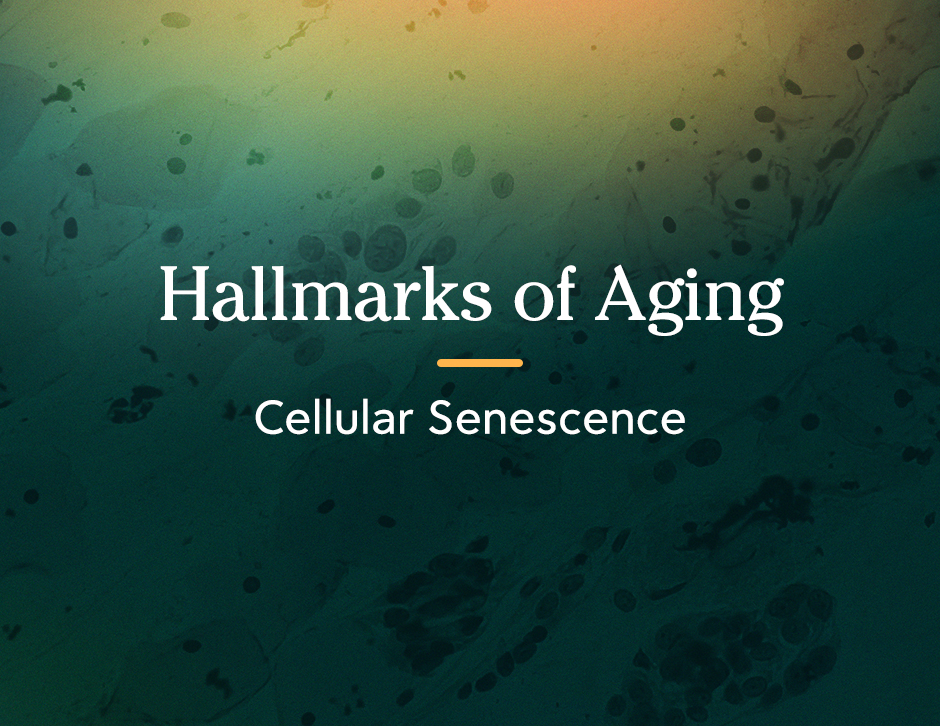
Quick overview of what you’ll learn from this blog post:
- What cellular senescence is
- Why it happens
- The consequences of cellular senescence
The Hallmarks of Aging describes cellular senescence as dysfunctional, pro-inflammatory cells which have evaded destruction. The accumulation of senescent cells is thought to be one of the reasons we age and is linked to many age-related diseases.
Damaged cells that refuse to die
As we age, an increasing number of our cells enter into a state called cellular senescence. In this state, cells no longer divide or contribute to the health of the tissues and organs they are a part of.
Normally these cells quickly dispose of themselves through a form of programmed self-destruct called apoptosis and are ready to be disposed of by the immune system.
Unfortunately, as with most things in the body, as we age this efficient disposal system begins to break down and increasing numbers of worn out and damaged cells evade apoptosis. To avoid destruction, these cells use a number of different genetic pro-survival pathways which also makes clearing them away challenging.
But they don’t just hang around doing nothing. Instead, they secrete a cocktail of pro-inflammatory signals that can lead to impaired tissue repair, an increase in chronic inflammation, and can also increase the risk of developing cancer and other age-related diseases.
This harmful cocktail contains cytokines, chemokines, and extracellular matrix proteases, all of which form the senescence-associated secretory phenotype, or SASP.
Exposure to SASP can even make nearby healthy cells become senescent too. In this way, a small number of senescent cells can have an impact that is far greater than their numbers.
These cells linger and by the time we reach old age, there are a significant number of them present in all our organs and tissues. And to make matters worse, the rate of accumulation speeds up as we get older, a bit like a snowball rolling down a mountainside growing and growing until it starts an avalanche.
Senescent cell burden can contribute to many age-related conditions, including atherosclerosis, type 2 diabetes, skin aging, and osteoarthritis.
What causes cellular senescence?
Telomere attrition is one of the main reasons our cells stop dividing and become senescent. This is where the protective caps on our chromosomes have become worn down to a critical point and the telomere stops the cell from dividing further to prevent mutations and cancer.
DNA damage can also trigger a cell to stop dividing and enter cellular senescence as a safety measure against mutations and cancer. In this way, sources such of radiation can cause cells to become senescent as can other forms of genotoxic stress.
Excessive mitogenic signaling is another potential reason for a cell to shut down and enter cellular senescence. Mitogenic signaling activates proteins that stimulate cell cycle progression. When that signaling is too fast it could be an indication of cancer, so the cell shuts down as a response to this danger.
Mitochondrial dysfunction can also lead to cellular senescence. Excessive amounts of reactive oxygen species, a byproduct of energy production, can also prompt the cell to enter senescence. Dysfunctional mitochondria increase the production of reactive oxygen species and can drive senescence and SASP secretion in this way.
Wound healing is another way cells can become senescent. However, in this case, doing so is positive, as it helps helps to facilitate tissue healing and immune response. This also means that the SASP does serve a useful function within this specific context and means completely removing it could be harmful.
What can we do about cellular senescence?
Research into tackling senescent cells is now well underway. In fact, researchers have already developed a number of potential approaches to control cellular senescence. These include:
- Destroying the problem cells using senolytic drugs
- Boosting the immune system so it can spot and remove senescent cells
- Reducing the SASP using senomorphic drugs
- Changing the cells behavior so when they become senescent there is less SASP
- Targeting dysfunctional mitochondria to reduce ROS in senescent cells
Metformin in particular has shown promise as an anti-inflammatory drug that reduces cellular senescence.
Scientists have also found that curcumin, a compound of, turmeric has potential senotherapeutic properties that can stifle cellular senescence. Curcumin is a central ingredient of Infinite Longevity Support, a unique supplementation pack designed to address all the hallmarks of aging. If you’re not sure which approach is right for you, consider starting with a longevity consultation to receive direct, one-on-one insight from a longevity doctor.
As research continues, we may soon have a targeted method of controlling cellular senescence and reducing our risk of disease. In the meantime, there are simple steps we can take at home to reduce our risk and improve our healthspan for years to come. Knowing where to start is the first step on your journey to more healthy years.
Note: The above statements have not been evaluated by the Food and Drug Administration. This product is not intended to diagnose, treat, cure, or prevent any disease.
